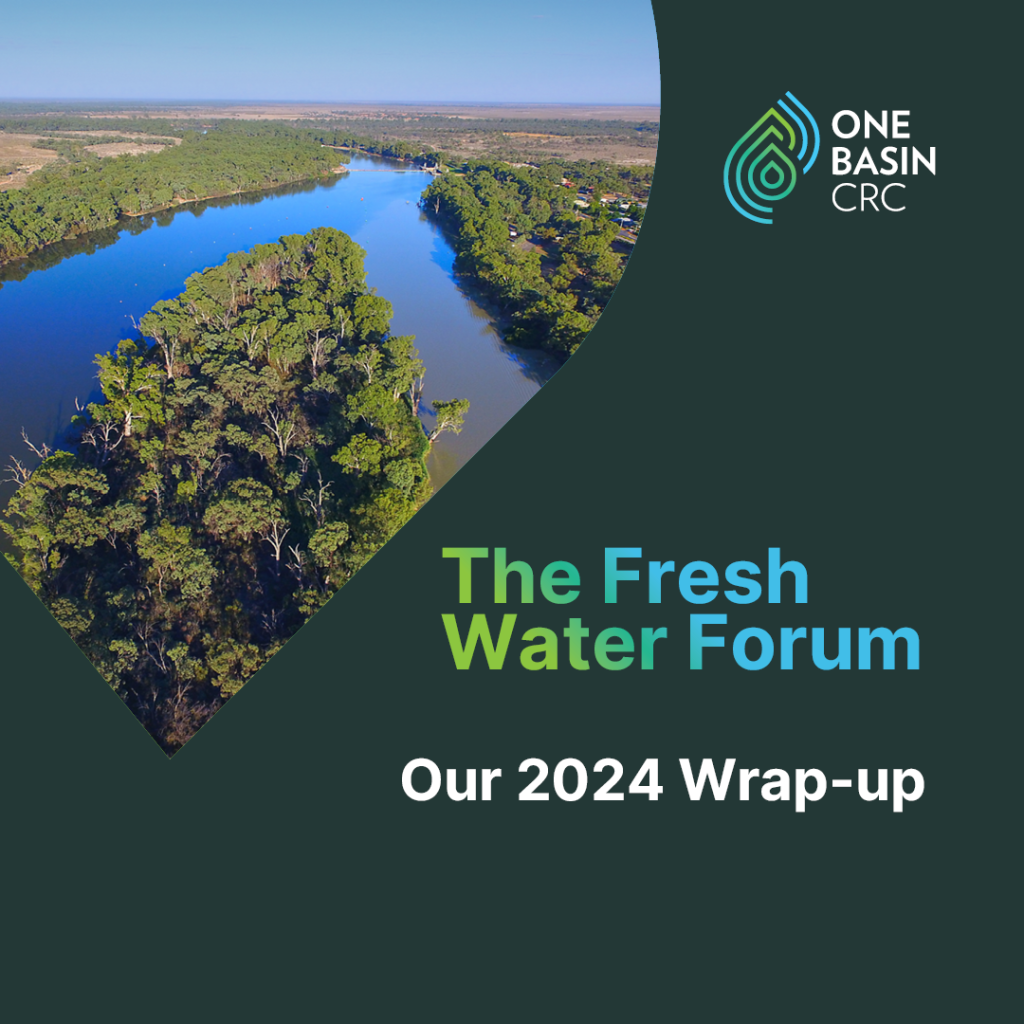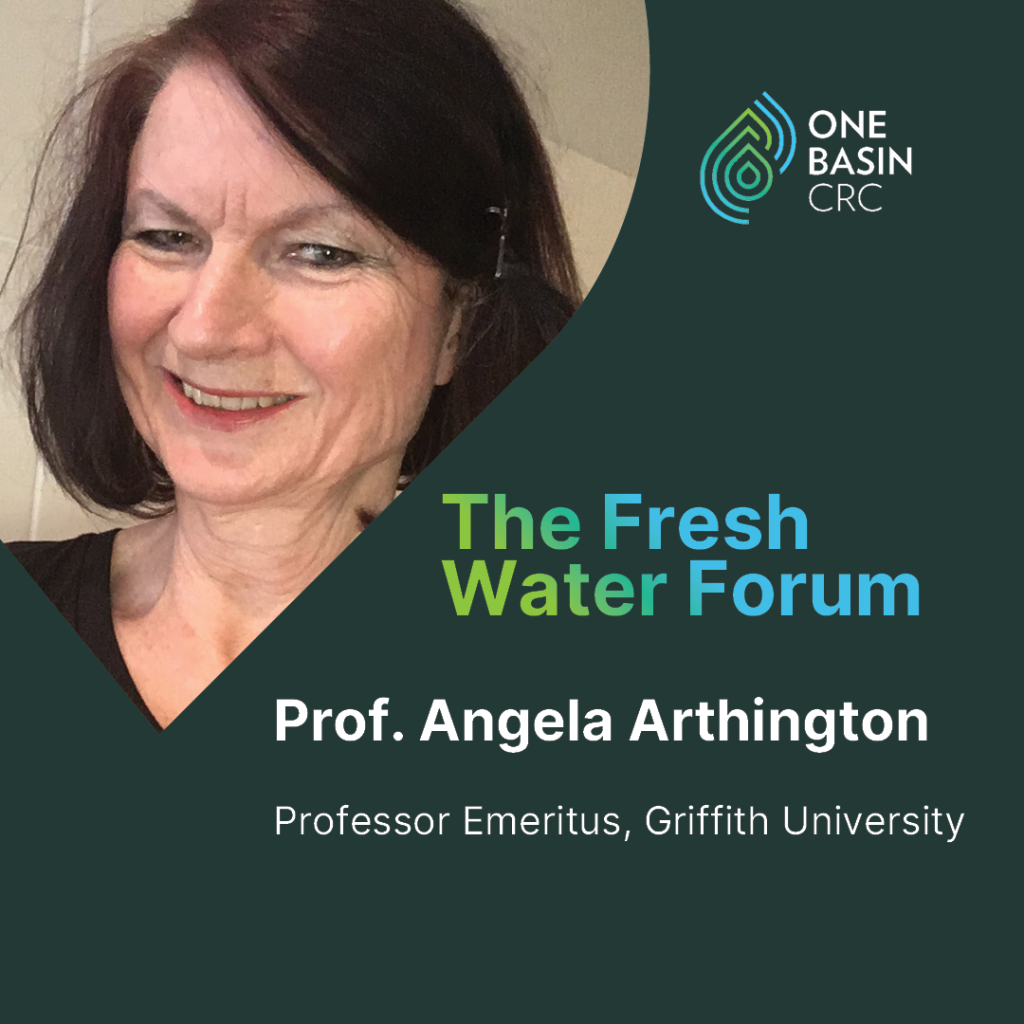What makes for impactful water research: learning from past success
news
Published 11 Apr 2025
By Professor Mike Stewardson
Over a series of interviews for The Fresh Water Forum, I explored three case studies – water-sensitive cities, environmental water policy reform, and total channel control technology – where water research has led to major positive outcomes. You can listen to these interviews here.
In the final episode, I was joined by One Basin CRC’s Avril Hogan and Prof. Seth Westra, for a deep dive into what it really takes for water research to make a lasting impact. We explored the three case studies to reveal shared ingredients for success. Spoiler: it’s not just about great ideas; it’s about collaboration, persistence, and perfect timing.

From Research to Real-World Change: The Long Game
One big takeaway? Impactful change takes time—often 10 to 15 years. It’s not just about doing the research; it’s about keeping the momentum, securing funding, and being ready when the right moment strikes. Take the millennium drought, for example. Years of research on water-sensitive design and environmental flows suddenly became crucial when Australia was in crisis. Solutions that had been simmering in the background were finally put into action.
So, what does it take to make research count?
- Collaboration across disciplines—no single field has all the answers.
- Long-term relationships and trust—it’s about who you know AND how well you work together.
- Consistent funding—big breakthroughs need more than one-off grants.
- Seizing the right moment—being ready when decision-makers are looking for answers.
The Secret Sauce: Cross-Disciplinary Collaboration
Despite working in different areas, all three case studies showed striking similarities in what made them successful. One key factor? Blending expertise across fields and sectors.
Prof Tony Wong, a leader in water-sensitive urban design, stressed the magic of combining deep disciplinary knowledge with cross-sector teamwork. Meanwhile, David Aughton, Executive Director of Rubicon Water, pointed out that not knowing the end goal from the start can actually be a good thing—it forces researchers to stay adaptable and open to unexpected solutions.

And let’s not forget the Cooperative Research Centres (CRCs). Jane Doolan, authority member with the MDBA, reflected that these organisations played a game-changing role by bringing together researchers, policymakers, and industry experts. Instead of working in silos, people were pooling knowledge and making progress together.
Why Problem Framing and Storytelling Matter
A great idea is only half the battle—you’ve got to frame the problem the right way and tell a story that sticks.
Tony Wong explained that defining the problem isn’t something you do once and forget about—it’s an ongoing conversation with stakeholders. Briony Rogers, Director of the Water Program for the Monash Sustainable Development Institute, highlighted that social scientists played a crucial role in reframing problems so they could actually be solved.
And then there’s Peter Cullen, who had a gift for storytelling. His ability to connect science and policy through compelling narratives was a major driver of change. The episode hammered home the point that effective communication requires:
- Telling compelling stories that get people invested.
- Using clear, simple language that bridges the gap between researchers and policymakers.
- Listening to stakeholders to ensure the research stays relevant and applicable.
The Challenge of Working Across Disciplines
Interdisciplinary collaboration sounds great in theory, but in practice? It’s tough. Even fields that seem closely related—like hydrology and ecology—often struggle to communicate because they:
- Use different technical languages.
- Approach problems from different theoretical angles.
- Have distinct professional cultures and ways of working.
Iven Mareels pointed out that specialisation has made collaboration even harder over time. But the good news? These challenges aren’t insurmountable. The key is:
- Investing in trust-building—relationships take time.
- Creating shared understanding—find the common ground.
- Encouraging open dialogue—learning from each other’s perspectives.
Why Long-Term Relationships and Trust Matter
If there’s one recurring theme, it’s this: Relationships drive results.
Angela Arthington shared how some of the most important breakthroughs happened during casual conversations—on walks, over coffee, or in relaxed settings. It’s not just about formal meetings and reports; it’s about creating the kind of trust and camaraderie that makes collaboration seamless.
The key ingredients?
- Genuine rapport—people work better when they actually like and respect each other.
- Years of sustained interaction—breakthroughs don’t happen overnight.
- Informal spaces for dialogue—sometimes the best ideas come outside of work hours.

The Make-or-Break Role of Institutional Support and Funding
Government and institutional backing are absolutely essential for turning research into action. The public sector often acts as the first customer for new technologies, funding early-stage innovations before they hit the mainstream.
But in recent years, declining research funding has created major challenges, leading to:
- Fragmented research efforts that lack continuity.
- Loss of expertise as researchers struggle to secure long-term support.
- Reduced collaboration since funding pressures push teams to focus inward.
When funding is steady and reliable, it enables:
- Stronger, long-term partnerships.
- Development of truly integrated solutions.
- Sustained research capacity to keep momentum going.
Timing Is Everything
Even the best research won’t have an impact if the timing isn’t right. Major transformations take a decade or more, but they only happen when external conditions align with ready-made solutions.
The millennium drought was a perfect example. Years of research into water-sensitive urban design and environmental flows were finally put into action because the crisis created an urgent need for solutions.
The takeaway?
- You have to be patient—real change takes time.
- Crises often serve as catalysts—be ready when opportunity knocks.
- Consensus-building before a crisis makes implementation much smoother when the time comes.
Big Picture Thinking: Transformations Across Generations
These three case studies are powerful reminder: today’s progress is built on yesterday’s efforts. The push for water-sensitive cities and environmental water policy reform wouldn’t have been possible without earlier research into environmental flows and CRC programs.
So how do we ensure that today’s work leads to tomorrow’s breakthroughs?
- Train the next generation of researchers and industry leaders.
- Foster strong industry partnerships that outlast individual projects.
- Build long-term networks of expertise that keep knowledge alive.
We reflect on First Nations perspective of planning for five generations ahead, a philosophy that aligns perfectly with the long-term nature of research impact. The idea? Think beyond the immediate and lay the groundwork for the future.
Final Takeaways
There are significant water challenges ahead for Australia with increasing water demands and growing variability and uncertainty in water availability. Charmaine Quick, MD of Goulburn Murray Water, said it very simply – we need new ways of doing more with less and share this really precious resource.
As water research programs like the One Basin CRC face tackle today’s water challenges, we should learn from past successes.
These podcast interviews were packed with insights on what it takes to move research from the lab to real-world impact. The biggest lessons?
- Collaboration is key—crossing disciplinary and sectoral lines leads to better outcomes.
- Communication matters—great ideas need great storytelling to gain traction.
- Trust and relationships drive change—long-term success depends on human connections.
- Funding must be sustained—research impact doesn’t happen in a single funding cycle.
- Be patient but ready—change takes time, but being prepared when the moment arrives makes all the difference.
The bottom line? Big transformations might seem sudden, but they’re actually the result of years—sometimes decades—of groundwork. If we want to keep solving complex challenges, we need to keep investing in research, collaboration, and the long game.
Latest news & events
All news & eventsWebinar recording: Working With Country To Heal
Read MoreBuilding capacity for Basin communities to respond to variable water futures
Read MoreDelivering the Commonwealth Environmental Water Holder’s (CEWH) Flow-MER 2025 Annual Forum
Read MoreMurray Darling Association 2025 National Conference: Griffith drives Basin-wide water collaboration
Read More